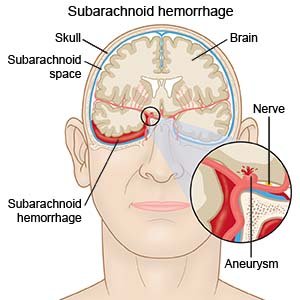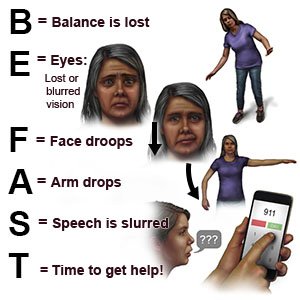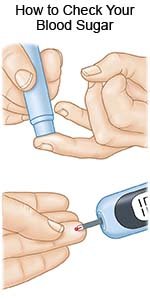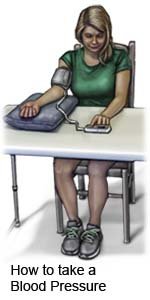Subarachnoid Hemorrhage
Medically reviewed by Drugs.com. Last updated on May 6, 2024.
What is a subarachnoid hemorrhage (SAH)?
SAH is a type of hemorrhagic stroke that causes bleeding in the subarachnoid space. This space is under the protective tissues that cover the brain. SAH happens when a blood vessel bursts. SAH is a life-threatening condition that needs immediate medical care.
 |
What increases my risk for SAH?
- An aneurysm (bulging area of a blood vessel) that has not burst, or hypertension (high blood pressure)
- A head injury
- A family history of SAH, or certain genetic diseases
- Being a woman or at least 50 years old
- Use of alcohol, cigarettes, or illegal drugs, such as cocaine or ecstacy
What are the warning signs of a stroke?
The words BE FAST can help you remember and recognize warning signs of a stroke:
- B = Balance: Sudden loss of balance
- E = Eyes: Loss of vision in one or both eyes
- F = Face: Face droops on one side
- A = Arms: Arm drops when both arms are raised
- S = Speech: Speech is slurred or sounds different
- T = Time: Time to get help immediately
 |
What are the signs and symptoms of SAH?
Rarely, you may have no signs or symptoms. You may have a sudden, severe headache that is worse than any headache you have ever had. This may be described as a thunderclap headache. It may happen within seconds and worsen within minutes. You may have a headache for days or weeks before the severe headache occurs. You may also have the following along with a moderate or severe headache:
- Nausea or vomiting
- Trouble walking
- Dizziness, drowsiness, faintness, or another person cannot wake you
- Double vision, eye pain in light, eyes pointing down and out, and drooping eyelids
- Stiff neck that may be the only symptom
- Numbness on one side of your body
- Trouble talking, reading, or writing
- Seizure
How is SAH diagnosed?
Your healthcare provider will ask if you have a history of SAH, blood vessel problems, or a recent head injury. He or she will ask which medicines you are taking. You may also need the following:
- CT pictures of your skull and brain may show bleeding in the subarachnoid space.
- A lumbar puncture , or spinal tap, may be used along with a CT scan. Your healthcare provider will remove fluid from around your spinal cord. The fluid will be checked for blood.
- Blood tests may be used to check your overall health. Your blood's ability to clot will also be tested. The tests may include a check for diabetes. Diabetes increases your risk for a stroke.
How is SAH treated?
You may need any of the following:
- Medicines may be given to lower your blood sugar level or blood pressure. A lower blood pressure may help prevent another SAH. It is also used to prevent stroke and heart or kidney damage caused by SAH. You may also need medicines for the effects of brain damage, or to help prevent seizures. Pain medicine may also be needed.
- Endovascular coils may be placed inside an aneurysm to prevent it from filling with blood. This may prevent the aneurysm from bursting.
- Surgery may be used to clip off an aneurysm to keep it from bursting.
Treatment options
The following list of medications are related to or used in the treatment of this condition.
What can I do to manage or prevent a SAH?
SAH is often caused by medical conditions that you cannot control. Healthcare providers will help you create goals for your recovery. The following lifestyle changes can help you reach your goals and lower your risk for a stroke:
- Manage health conditions. A condition such as diabetes can increase your risk for a stroke. Control your blood sugar level if you have hyperglycemia or diabetes. Take your prescribed medicines and check your blood sugar level as directed.

- Check your blood pressure as directed. High blood pressure can increase your risk for a stroke. Follow your healthcare provider's directions for controlling your blood pressure.

- Do not use nicotine products or illegal drugs. Nicotine and other chemicals in cigarettes and cigars can cause blood vessel damage and raise your risk for an aneurysm. A burst aneurysm is one of the main causes of SAH. Nicotine and illegal drugs both increase your risk for a stroke. Ask your healthcare provider for information if you currently smoke or use drugs and need help to quit. E- cigarettes or smokeless tobacco still contain nicotine. Talk to your healthcare provider before you use these products.
- Do not drink alcohol. Alcohol increases your risk for a stroke. Alcohol may also raise your blood pressure or thin your blood. Blood thinning can cause a hemorrhagic stroke.
- Eat a variety of healthy foods. Healthy foods include whole-grain breads, low-fat dairy products, beans, lean meats, and fish. Eat at least 5 servings of fruits and vegetables each day. Choose foods that are low in fat, cholesterol, salt, and sugar. Eat foods that are high in potassium, such as potatoes and bananas. A dietitian can help you create healthy meal plans.

- Maintain a healthy weight. Ask your healthcare provider what a healthy weight is for you. Ask him or her to help you create a weight loss plan if you are overweight. He or she can help you create small goals if you have a lot of weight to lose.
- Exercise as directed. Exercise can lower your blood pressure, cholesterol, weight, and blood sugar levels. Healthcare providers will help you create exercise goals. They can also help you make a plan to reach your goals. For example, you can break exercise into 10 minute periods, 3 times in a day. Find an exercise that you enjoy. This will make it easier for you to reach your exercise goals.

- Manage stress. Stress can raise your blood pressure. Find new ways to relax, such as deep breathing or listening to music.
Where can I find more information?
- American Stroke Association
Phone: 1- 888 - 478-7653
Web Address: http://www.stroke.org
Have someone call your local emergency number (911 in the US) if:
- You have any of the following signs of a stroke:
- Numbness or drooping on one side of your face
- Weakness in an arm or leg
- Confusion or difficulty speaking
- Dizziness, a severe headache, or vision loss

- You have a mild to moderate headache that lasts a few days.
- You have eye pain when you are in bright light, or you see double.
- You have a seizure, or someone sees you lose consciousness.
When should I call my doctor?
- You have neck stiffness that does not go away.
- You have questions or concerns about your condition or care.
Care Agreement
You have the right to help plan your care. Learn about your health condition and how it may be treated. Discuss treatment options with your healthcare providers to decide what care you want to receive. You always have the right to refuse treatment. The above information is an educational aid only. It is not intended as medical advice for individual conditions or treatments. Talk to your doctor, nurse or pharmacist before following any medical regimen to see if it is safe and effective for you.© Copyright Merative 2024 Information is for End User's use only and may not be sold, redistributed or otherwise used for commercial purposes.
Learn more about Subarachnoid Hemorrhage
Treatment options
- Medications for Head Injury w/ Intracranial Hemorrhage and Loss of Consciousness
- Medications for Head Injury with Intracranial Hemorrhage
- Medications for Subarachnoid Hemorrhage
Symptoms and treatments
Further information
Always consult your healthcare provider to ensure the information displayed on this page applies to your personal circumstances.
